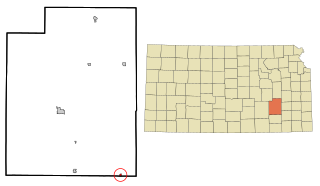
Moran is a city in Allen County, Kansas, United States. As of the 2020 census, the population of the city was 466.

Fort Scott is a city in and the county seat of Bourbon County, Kansas, United States. As of the 2020 census, the population of the city was 7,552. It is named for Gen. Winfield Scott. The city is located 88 miles (142 km) south of Kansas City on the Marmaton River. It is the home of the Fort Scott National Historic Site and the Fort Scott National Cemetery.

Augusta is a city in Butler County, Kansas, United States. As of the 2020 census, the population of the city was 9,256. It is located east of Wichita along U.S. Route 54 / 400 highway.

Douglass is a city in Butler County, Kansas, United States. As of the 2020 census, the population of the city was 1,555.

Burlington is a city in and the county seat of Coffey County, Kansas, United States. As of the 2020 census, the population of the city was 2,634.

Howard is a city in and the county seat of Elk County, Kansas, United States. As of the 2020 census, the population of the city was 570.

Milford is a city in Geary County, Kansas, United States. As of the 2020 census, the population of the city was 408.

Gove City, more commonly known as Gove, is a city in and the county seat of Gove County, Kansas, United States. As of the 2020 census, the population of the city was 80.

Fall River is a city in Greenwood County, Kansas, United States. As of the 2020 census, the population of the city was 131.

Jetmore is a city in and the county seat of Hodgeman County, Kansas, United States. As of the 2020 census, the population of the city was 770.

Kingman is a city in and the county seat of Kingman County, Kansas, United States. As of the 2020 census, the population of the city was 3,105.

Inman is a city in McPherson County, Kansas, United States. As of the 2020 census, the population of the city was 1,341.

Meade is a city in and the county seat of Meade County, Kansas, United States. As of the 2020 census, the population of the city was 1,505.

Paola is a city in and the county seat of Miami County, Kansas, United States. As of the 2020 census, the population of the city was 5,768.

Cherryvale is a city in Montgomery County, Kansas, United States. As of the 2020 census, the population of the city was 2,192.

Phillipsburg is a city in and the county seat of Phillips County, Kansas, United States. As of the 2020 census, its population was 2,337.

Atwood is a city in and the county seat of Rawlins County, Kansas, United States. As of the 2020 census, the population of the city was 1,290.

Randolph is a city in Riley County, Kansas, United States. As of the 2020 census, the population of the city was 159.

Plainville is a city in Rooks County, Kansas, United States. As of the 2020 census, the population of the city was 1,746. It was named from its setting upon the plains.

Leoti is a city in and the county seat of Wichita County, Kansas, United States. As of the 2020 census, the population of the city was 1,475.























